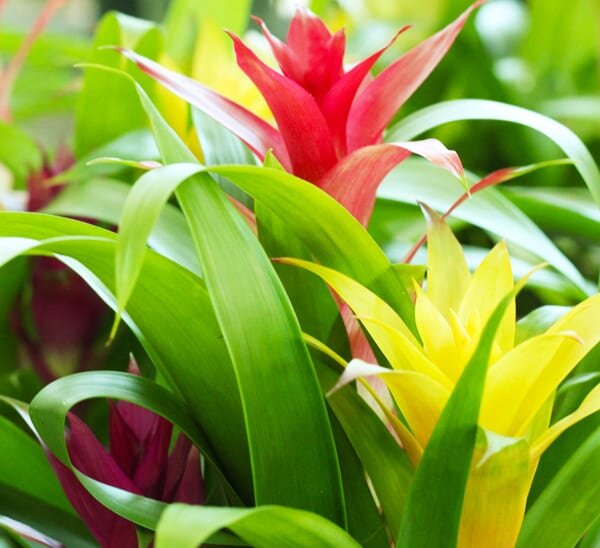
BROMELIAD
Bromeliad plants provide a tropical touch to the home or warm season landscape, with their striking green foliage and brightly colored, fountain-like flowers. Luckily, they are one of the easiest indoor flowering plants to grow in the home.
Bromeliads are members of the Bromeliaceae family, which spans 76 genera and over 3,000 species. They are found growing natively in South America, with the most diversity of species in Brazil. Tillandsias, known commonly as air plants, and pineapple plants are both members of this family. In this text, we will be going over flowering bromeliads that are commonly grown in homes, with wide, flat leaves, and large flowers. They are typically derived and hybridized from the genus Canistropsis.
WATER & SOIL
Bromeliads are typically found in humid, tropical areas growing epiphytically (which is just the technical term for growing on trees). Due to the plants being epiphytic, they need to dry between waterings. They like rich, well draining soil, and prefer a pot with drainage. When caring for broms indoors, the soil should go almost fully dry, then be given a deep watering.
Bromeliads can be prone to crown rot, so be careful not to let water stand between the leaves. There are a few species that actually like to have water there, but most of them do not, so look into your individual plant if you are curious.
LIGHT
Bromeliads are able to hold on to their color for much longer than most other indoor bloomers, lasting anywhere from 2-8 months. When in bloom, bromeliad flowers will last longest in a medium to low-light setting. After they are done blooming, if the plant produces offsets or “pups”, the plant will prefer bright indirect light in order to grow out the foliage–and possibly produce a bloom from the new plant when it matures!
FERTILIZER
Bromeliads are not too demanding of fertilizer, and any balanced houseplant fertilizer should do the trick.
SPECIAL NOTES
Bromeliads, with few exceptions, will only bloom once per plant. When bromeliads are done blooming, they will start to put their energy into creating plantlets that will continue on. The mother plant (referring to the plant that the pups grow from) may stay green long enough for a pup or two to reach maturity, but will eventually die back. It is just part of its life cycle, so don’t be too worried if the mother plant begins to die back and the pup is still green. Pups can be left on the mother plant or separated into their own pots once they have developed their own root system.




